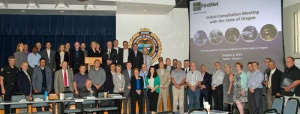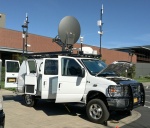In February, 2012 the First Responder Network Authority (FirstNet) was created and funded with $7 billion by Congress to build a nationwide wireless network for responders to daily incidents and larger disasters. I sometimes call it a cellular network to connect the smart phones and tablets of cops and firefighters, but, really, anyone who responds to disasters will probably be able to use it.
FirstNet is required to consult with state governments about its plans, and then develop a design and plan for each state. This state plan will include what parts of the state will be covered, who can use the network in the state, and what the costs will be.
FirstNet is starting to launch the consultation and design process, state by state. I was fortunate to be present on October 8th when FirstNet staff conducted their initial consultation with officials in the state of Oregon at the Department of Public Safety Standards and Training (DPSST) in Salem. Steve Noel, Oregon Statewide Interoperability Coordinator (SWIC) hosted the meeting. This is the third initial consultation of 56 states and territories where FirstNet will be constructed. The State of Washington is next up for an initial consultation, which occurs on October 16th.
Here are a few of my impressions from Oregon’s consultation.
I was most intrigued to hear real-world examples of communications needs from Oregon’s responders.
Chief Mike Duyck from the Tualatin Valley Fire & Rescue, vice-chair of the Oregon State Interoperability Executive Council, eloquently spoke about the communications needs and possibilities of FirstNet. He spoke about “geo-fencing” physical addresses, so when responders were called to a specific address, they would know if people with arrest warrants or histories of violence lived or frequented nearby locations. He talked about crowdsourcing off-duty responders who are physically close to major incidents, video conferencing physicians from the scene of a medical emergency, and interconnecting traditional public safety land-mobile radios with smart phones and other cellular devices. All-in-all, his talk was an eye-opening vision of the future of public safety communications from an active, engaged fire chief.
Cheryl Bledsoe from the Clackamas County 9-1-1 office talked about the combined use of land-mobile radio, cell phones and social media like twitter responding to the 2012 Clackamas Mall shooter.
Bledsoe, who is a prolific tweeter herself, said the first tweets from terrified citizens at the mall occurred more than two minutes before the first 911 call (see also Huffington Post article about that here). She also related how a senior official of the Clackamas Sheriff’s department got the first word of the shooting from his daughter via a cell phone call. She was watching social media and noticed news of the shooting, then called her dad. My lesson from this story: public safety needs to continue to embrace and enhance its use of smart phone apps and social media, and even the two-way use of platforms like twitter (Seattle Police are one of the best at two-way tweeting.)
Some of Oregon’s first responders are actively adopting commercial high-speed mobile data networks for innovative use today. Sheriff Mike Winters, Sergeant Rick Kennedy and Jenny Hall from the Jackson County Sheriff’s department (tweeting here) brought their communications vehicle and demonstrated their use of wireless video. They showed live video from their communications center 150 miles away, and talked about the use of live video from helicopter feeds as well as fixed locations. They are hungry for more bandwidth and eagerly await the implementation of FirstNet to help with that. All Jackson County deputies use smart phones which include both GPS location (so they know where other deputies are located) and applications like an interconnection to their Land-Mobile Radio network. They also can access video from schools in the county (when authorized by the school).
David Buchanan, Rich Reed and Brian Hobson led the FirstNet team meeting with Oregon. David has blogged about his observations here. I was impressed by the team’s attentiveness to the concerns of Oregon’s responders, and by their honesty. Rich Reed, FirstNet’s director of state plans, says “there are some things we know, many things we don’t know, and some things we believe” about how FirstNet will roll out nationwide. By coming to Oregon and other states they are hoping to expand the “things they know”.
A few other observations, in no particular order:
- FirstNet staff emphasized again and again that the network needs to be self-sustaining – FirstNet has to find sources of income to match its operational costs and investment needs. At the same time it must be affordable to responder agencies, many of whom do not use commercial networks today, or only use them in a limited fashion.
- Oregon responders urged FirstNet to make the per-device cost equal to or less than the costs they presently pay to commercial carriers.
- Police Chief Rock Rakosi, chair of the Oregon SIEC, eloquently spoke about the need to provide coverage for rural agencies, even though there will not necessarily be significant income for FirstNet from a rural build-out.
- Some of those present in the room cited the need for subsidies for responding agencies with very limited budgets and potentially for volunteer firefighters or search-and-rescue volunteers.
- Rich Reed discussed the challenge of getting FirstNet’s band 14 chips into commercial devices. He noted the new iPhone 6 has 20 different LTE spectrum bands/chips but not Band 14.
- Karl Larson of the City of Portland raised the need for procurement contracts and vehicles in each state, so that cities, counties, state agencies and other responder entities could legally procure FirstNet services and devices.
- Brian Hobson said FirstNet has acquired Mentum Planet modeling software to help it design coverage for states.
- Each of the 56 states and territories who will be FirstNet partners has a “State Point of Contact” or SPOC. Steve Noel invited SPOCs from each state bordering Oregon to attend this event, and we all did: Rob Feeley of Idaho, George Molnar of Nevada, Karen Wong of California and my team from Washington.
- Another critical success factor is adoption by public safety agencies and other responders.
- According to FirstNet’s market research, sustainability is achievable as FirstNet doesn’t have to make a profit, support high overhead costs, pay spectrum licensing fees, turn a profit to (or satisfy) shareholders. (Schrier’s note: although FirstNet does have to satisfy its public safety user base, who are a tough crowd).
I’m looking forward to FirstNet’s coming to Washington on October 16th to have a similar dialog with our public safety leaders and other responders. More details about that event on Washington OneNet’s website here.
(This post was slightly updated on October 15, 2014, to add the comment from Chief Rakosi and correct a minor spelling error.)






